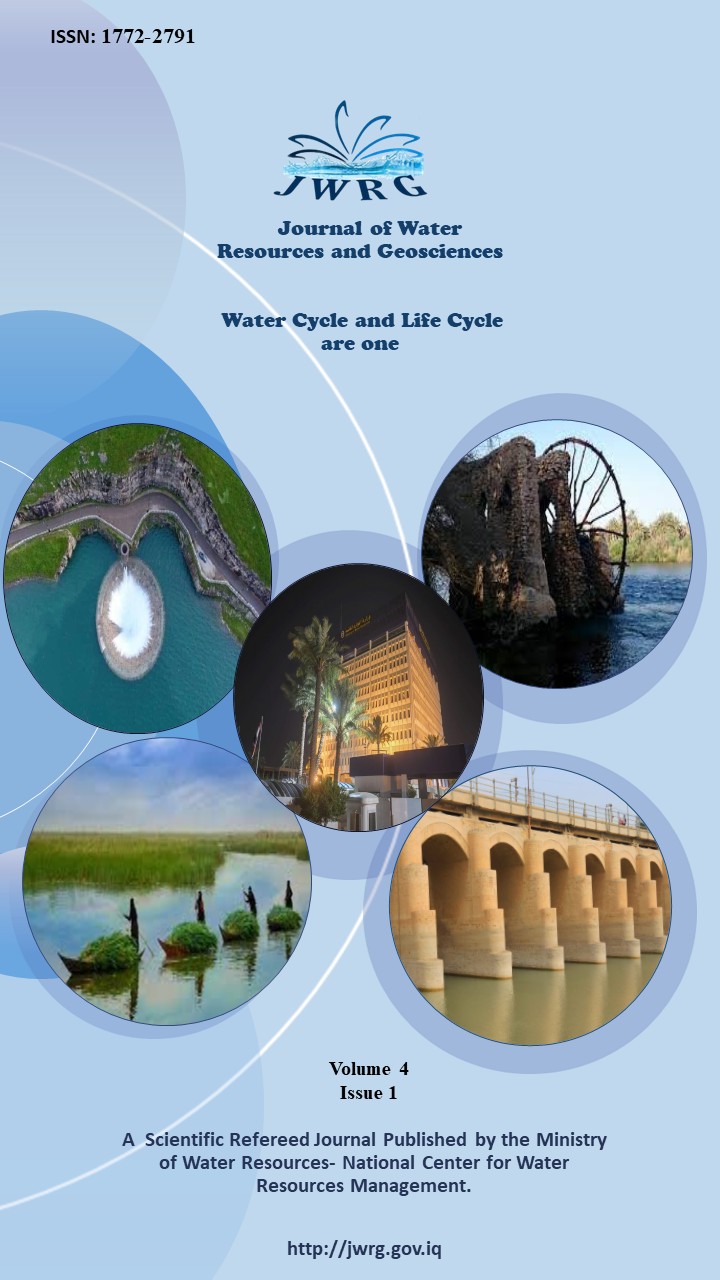Forecasting of Irrigation Water Requirements in Wasit Province under Climate Change Conditions using LARS-WG and CROPWAT-8 Models
Abstract
Agriculture is the largest consumer of surface and groundwater globally. Due to climate change, the demand for irrigation water will shift. In Iraq, climate change involves increased temperatures and decreased rainfall. In this study, the maximum and minimum temperatures and rainfall for Al-Kut station during the reference period from 1990 to 2019 were downscaled to the period from 2030 to 2050 using the LARS-WG model, based on the HadGEM2-ES climate model and the RCP4.5 scenario. Additionally, irrigation requirements for Wasit Governorate were calculated using the CROPWAT-8 program for both the reference and future periods. The results indicate that the annual average of maximum and minimum temperatures will rise by 1.44°C and 1.24°C, respectively. This will lead to an increase in the annual evaporation rate from 2721.3 mm/year to 2848.2 mm/year. Similarly, the demand for irrigation water is projected to increase by about 36.7 m³/s due to these updated climatic factors. Therefore, it is essential to adopt more efficient irrigation methods to reduce pressure on water resources, which are also declining due to climate change.
References
Abtew, W., & Melesse, A. (2013). Evaporation and evapotranspiration: Measurements and estimations. Evaporation and Evapotranspiration: Measurements and Estimations, 9789400747, 1–206. https://doi.org/10.1007/978-94-007-4737-1
Allen, Richard G., PEREIRA, Luis S., RAES, Dirk and SMITH, M. (1998). FAO Irrigation and Drainage Paper Crop by. Irrigation and Drainage, 300(56), 300. http://www.kimberly.uidaho.edu/water/fao56/fao56.pdf
Awchi, T. A., & Kalyana, M. M. (2017). Meteorological drought analysis in northern Iraq using SPI and GIS. Sustainable Water Resources Management, 3(4), 451–463. https://doi.org/10.1007/s40899-017-0111-x
Ewaid, S. H., Abed, S. A., & Al-Ansari, N. (2019). Crop water requirements and irrigation schedules for some major crops in southern Iraq. Water (Switzerland), 11(4). https://doi.org/10.3390/w11040756
Fischer, G., Tubiello, F. N., van Velthuizen, H., & Wiberg, D. A. (2007). Climate change impacts on irrigation water requirements: Effects of mitigation, 1990-2080. Technological Forecasting and Social Change, 74(7), 1083–1107. https://doi.org/10.1016/j.techfore.2006.05.021
Fuka, D. R., Walter, M. T., Macalister, C., Degaetano, A. T., Steenhuis, T. S., & Easton, Z. M. (2014). Using the Climate Forecast System Reanalysis as weather input data for watershed models. Hydrological Processes, 28(22), 5613–5623. https://doi.org/10.1002/hyp.10073
Gorguner, M., & Kavvas, M. L. (2020). Modeling impacts of future climate change on reservoir storages and irrigation water demands in a Mediterranean basin. Science of the Total Environment, 748, 141246. https://doi.org/10.1016/j.scitotenv.2020.141246
Haskett, J. D., Pachepsky, Y. A., & Acock, B. (2000). Effect of climate and atmospheric change on soybean water stress : a study of Iowa. 135, 265–277.
Holsten, A., Vetter, T., Vohland, K., & Krysanova, V. (2009). Impact of climate change on soil moisture dynamics in Brandenburg with a focus on nature conservation areas. Ecological Modelling, 220(17), 2076–2087. https://doi.org/10.1016/j.ecolmodel.2009.04.038
IPCC. (2014). Climate Change 2014: Synthesis Report. Contribution. In Climate Change 2014: Synthesis Report. Contribution of Working Groups I, II and III to the Fifth Assessment Report of the Intergovernmental Panel on Climate Change.
Japan International Cooperation Agency, J. (2016). Data Collection Survey on Water Resource Management and Agriculture Irrigation in the Republic of Iraq. April, 125.
Jaradat, A. (2003). Agriculture in Iraq: Resources, potentials, constraints, research needs and priorities. Agriculture, 83. http://ddr.nal.usda.gov/dspace/handle/10113/47863
Konzmann, M., Gerten, D., & Heinke, J. (2013). Impacts climatiques selon 19 MCG sur les besoins globaux en irrigation simulés par un modèle d’hydrologie et de végétation. Hydrological Sciences Journal, 58(1), 88–105. https://doi.org/10.1080/02626667.2013.746495
Lelieveld, J., Hadjinicolaou, P., Kostopoulou, E., Chenoweth, J., El Maayar, M., Giannakopoulos, C., Hannides, C., Lange, M. A., Tanarhte, M., Tyrlis, E., & Xoplaki, E. (2012). Climate change and impacts in the Eastern Mediterranean and the Middle East. Climatic Change, 114(3–4), 667–687. https://doi.org/10.1007/s10584-012-0418-4
Mondal, P., Jain, M., Robertson, A. W., Galford, G. L., Small, C., & Defries, R. S. (2014). Winter crop sensitivity to inter-annual climate variability in central India. 61–76. https://doi.org/10.1007/s10584-014-1216-y
Ouarda, T. B. M. J., Charron, C., Kumar, K. N., Phanikumar, D. V., Molini, A., & Basha, G. (2019). Nonstationary warm spell frequency analysis integrating climate variability and change with application to the Middle East. Climate Dynamics, 53(9–10), 5329–5347. https://doi.org/10.1007/s00382-019-04866-2
Rai, R. K., Singh, V. P., & Upadhyay, A. (2017). Chapter 12 - Irrigation Scheduling. Planning and Evaluation of Irrigation Projects, 385–412. http://www.sciencedirect.com/science/article/pii/B9780128117484000121
Salman, S. A., Shahid, S., Ismail, T., Ahmed, K., & Wang, X. J. (2018). Selection of climate models for projection of spatiotemporal changes in temperature of Iraq with uncertainties. Atmospheric Research, 213, 509–522. https://doi.org/10.1016/j.atmosres.2018.07.008
Semenov, M. A., & Barrow, E. M. (2002). LARS-WG: A Stochastic Weather Generator for Use in Climate Impact Studies version 3. User Manual. User Manual, Hertfordshire, UK, August, 27.
Semenov, M. A., Brooks, R. J., Barrow, E. M., & Richardson, C. W. (1998). Comparison of the WGEN and LARS-WG stochastic weather generators for diverse climates. Climate Research, 10(2), 95–107. https://doi.org/10.3354/cr010095
Shalhevet, J., & Bielorai, H. (1978). Crop water requirement in relation to climate and soil. In Soil Science (Vol. 125, Issue 4, pp. 240–247). https://doi.org/10.1097/00010694-197804000-00008
Sowers, J., Vengosh, A., & Weinthal, E. (2011). Climate change, water resources, and the politics of adaptation in the Middle East and North Africa. Climatic Change, 104(3–4), 599–627. https://doi.org/10.1007/s10584-010-9835-4
Waha, K., Krummenauer, L., Adams, S., Aich, V., Baarsch, F., Coumou, D., Fader, M., Hoff, H., Jobbins, G., Marcus, R., Mengel, M., Otto, I. M., Perrette, M., Rocha, M., Robinson, A., &
Schleussner, C. F. (2017). Climate change impacts in the Middle East and Northern Africa (MENA) region and their implications for vulnerable population groups. Regional Environmental Change, 17(6), 1623–1638. https://doi.org/10.1007/s10113-017-1144-2
Wang, Z., Zheng, H., & Wang, X. (2009). A Harmonious Water Rights Allocation model for Shiyang River Basin, Gansu Province, China. International Journal of Water Resources Development, 25(2), 355–371. https://doi.org/10.1080/07900620902868836
Wasimi, S. A. (2010). Climate change in the Middle East and North Africa (MENA) region and implications for water resources project planning and management. International Journal of Climate Change Strategies and Management, 2(3), 297–320.


